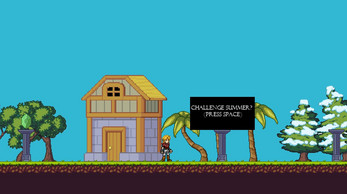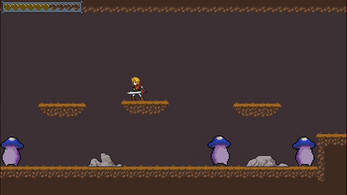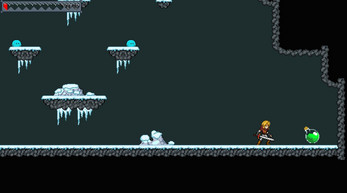Seasons of Chaos
A downloadable game
Description:
Seasons of Chaos is a platforming game with basic combat. The game follows Robin, an ordinary traveler who has been affected by the strange arrival of calamitous seasonal weather. The harsh seasons are decimating humanity and the natural land. Even worse, monsters are appearing all over the world. Given supernatural powers by a mysterious, desperate, and divine figure, Robin is the only one who can traverse the seasonal extremities and bring back balance to the land.
The game consists of four main areas, each one themed on a specific season (Summer, Fall, Winter, and Spring). Essentially, each season has the same basic structure. They all have three unique platforming levels and a boss level. These levels consist of stationary floating platforms, moving floating platforms and three to four unique common enemies per season. Healing potions will be scarce and usually hidden to encourage exploration and careful movement.
In its entirety, a new player should expect to spend approximately twenty minutes completing Seasons of Chaos. A seasoned platforming game player may be able to beat the game in ten to fifteen minutes. However, even master players will have some challenges with the later levels in each season.
Controls:
W : Jump
A : Move left
D : Move right
Space Bar : Attack and select levels in the hub world
P : Pause / Resume game
H : Return to the hub world (only when paused)
Q : Return to Title Screen (only when paused)
Backspace : Restart level (only when paused)
Post Mortem:
As a team, we are particularly proud of the fact that the majority of the sprites and animation designs were created by us. The dedication and attention we gave to incorporating our player, terrain, enemies, signs, several backgrounds, the hub world, and other sprites to create the best visual experience was an incredible undertaking that we were able to excel in. Visually, we believe that our game rivals some of the many successful and widely known pixelated platformer games that are currently out on the market.
Also, our team’s communication throughout this project was great! By implementing dedicated channels for all of our different topics of discussions, we were always able to know what was going on with our pressing issues without having to sift through other ongoing discussions. However, even though our communication was superb, it could have been much better.
Most notably, a common issue that we ran into was that while we knew what problems were being worked on, we were not always constantly sure who was working on them. This had the often-occurring effect of two people accidentally creating solutions to the same problems. From these unfortunate experiences, we all learned that communication, no matter how obvious the matter is, is crucial for future large scale projects.
Also, our creative minds were a key pain for us. Our ideation process was a lengthy time period where all five of us were constantly putting ideas in our Discord server’s “idea-dump” channel with each idea spawning about five to seven sub ideas. The dopamine rush we all got after putting forth each of our ideas became addicting, and this rush blinded us from seeing that we were getting too ambitious with our game.
Upon receiving feedback from the graders on our heavily detailed design document, we were told that our game was too wildly ambitious. However, we still tried to keep all of our ideas. But, inevitably, our item system, open world exploration feature, unique bosses, and more features disappeared from our plans due to time constraints. Cutting these features felt horrible each time. However from this, we all learned the invaluableness of not dwelling on the ideation process, showing restraint to add new features, and falling in love with too many ideas.
Our team also learned the importance of asking for clarification and the awfulness of not doing our own research. Coupled with not going to office hours, following out of date tutorials, and especially not checking future lecture presentations for learning integral functions and concepts, our team constantly encountered roadblocks.
Unfortunately, some bugs still remain in the build that we have published to Itch.io. For one, when a player jumps into a moving platform’s sides, they will get stuck into the platform and will move along with it. The only way to escape this issue is to repeatedly attack, as this will momentarily keep the player in a set x and y position. Then, the platform will eventually leave and the player will fall to the ground. Similarly, if the player is on the moving platforms and attacks, Robin will not move from his x and y positions, but the moving platform will. Thus, the player will either clip though or fall off if on vertically moving and horizontally moving platforms, respectively.
These bugs are most likely due to the systems that keeps the player stationary when attacking and unable to attack in the air. In detail, the moving platforms’ glitch is most likely caused by the computer believing the y Velocity of 0 shows that the player is on the ground. Thus, when attacking, the stationary system keeps the player from moving. Unfortunately, we were never able to figure out how to easily fix this problem. Having discovered this bug fairly recently with no ample time left in the semester, we were unable to rework the fundamentals of our game’s attacking code.
Three visual bugs we also encountered and could not solve were the animation endings for the vine enemy, eel enemy, and Robin’s sword attack. For the enemies, if the player leaves the trigger distance in the middle of the enemies’ animation, then the animation will abruptly cut and revert back to its idle animation. Depending on how often the player attacks, the attacking animation will sometimes loop and cut off before the animation ends.
For the sword, depending on how long and how often the attack button is pressed, the sword animation will play again and can cut off at the beginning of the second animation’s play. Unfortunately, even with committing outside research, attempting to bend the lecture slides to our purposes, and reading GameMaker Studio’s documentation, we were not able to make these enemies and the sword finish their animations correctly and naturally.
In conclusion, Seasons of Chaos was an enlightening experience for everyone who worked on it. Nicholas and Diya were able to learn, practice, and implement their artistic brilliance, Cameron was able to learn how different types of video game players think and incorporated this knowledge into the level design, Caleb was able to learn the very fine intricacies of the GameMaker Language, and Basim was able to also learn about this programming language as well as the roles, responsibilities, and management strategies of being a successful leader for a project bigger than everyone on the team!
Team Members:
Basim Khokhar - Producer and Programmer
Caleb Yazzie - Level Designer and Programmer
Cameron Keck - Lead Level Designer and Programmer
Diya Bhandarkar - Artist and Programmer
Nicholas Cruise - Artist and Programmer
| Status | Prototype |
| Author | SeasonsOfChaos |
| Genre | Platformer |
| Tags | Boss battle, Fantasy, GameMaker, Pixel Art, Singleplayer |
Download
Install instructions
First, download the zip file. Afterwards, extract the contents. Then, click on the GameMaker application file and save the world!




